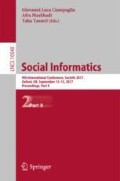Abstract
Interest in data-driven crime simulations has been growing in recent years, confirming its potential to advance crime prevention and prediction. Especially, the use of new data sources in crime simulation models can contribute towards safer and smarter cities. Previous work on agent-based models for crime simulations have intended to simulate offender behavior in a geographical environment, relying exclusively on a small sample of offender homes and crime locations. The complex dynamics of crime and the lack of information on criminal offender’s movement patterns challenge the design of offender movement in simulations. At the same time, the availability of big, GPS-based user data samples (mobile data, social media data, etc.) already allowed researchers to determine the laws governing human mobility patterns, which, we argue, could inform offender movement. In this paper, we explore: (1) the use of location-based venue data from Foursquare in New York City (NYC), and (2) human dynamics insights from previous studies to simulate offender movement. We study 9 offender mobility designs in an agent-based model, combining search distances strategies (static, uniform distributed, and Lévy-flight approximation) and target selection algorithms (random intersection, random Foursquare venues, and popular Foursquare venues). The offender behavior performance is measured using the ratio of crime locations passed vs average distance traveled by each offender. Our initial results show that agents moving between POI perform best, while the performance of the three search distance strategies is similar. This work provides a step forward towards more realistic crime simulations.
Notes
- 1.
Area between usual activity nodes.
- 2.
Foursquare is a mobile application offering location-search-and-discovery for its users: https://foursquare.com/.
- 3.
References
Gerritsen, C., Elffers, H.: Investigating prevention by simulation methods. In: LeClerc, B., Savona, E.U. (eds.) Crime Prevention in the 21st Century. Insightful Approaches for Crime Prevention Initiatives. Springer, Cham, Switzerland (2017)
Brantingham, P.J., Tita, G.: Offender mobility and crime pattern formation from first principles. In: Liu, L., Eck, J. (eds.) Artificial Crime Analysis Systems. Using Computer Simulations and Geographic Information Systems, Information Science Reference, Hershey, N.Y., London (2008)
Birks, D.J., Townsley, M., Stewart, A.: Emergent regularities of interpersonal victimization. an agent-based investigation. J. Res. Crime Delinquency 51(1), 119–140 (2014)
Dray, A., Mazerolle, L., Perez, P., Ritter, A.: Policing Australia’s ‘heroin drought’. using an agent-based model to simulate alternative outcomes. J. Experimental Criminol. 4(3), 267–287 (2008)
Devia, N., Weber, R.: Generating crime data using agent-based simulation. Comput. Environ. Urban Syst. 42, 26–41 (2013)
Hayslett-McCall, K.L., Qiu, F., Curtin, K.M., Chastain, B., Schubert, J., Carver, V.: The simulation of the journey to residential burglary. In: Liu, L., Eck, J. (eds.) Artificial Crime Analysis Systems. Using Computer Simulations and Geographic Information Systems. Information Science Reference, Hershey, N.Y., London, pp. 281–299 (2008)
Gunderson, L., Brown, D.: Using a multi-agent model to predict both physical and cyber criminal activity. In: Proceedings of the IEEE International Conference on Systems, Man and Cybernetics. Cybernetics Evolving to Systems, Humans, Organizations, and their Complex Interactions, vol. 4, Piscataway, pp. 2338–2343 (2000)
Peng, C., Kurland, J.: The agent-based spatial simulation to the burglary in Beijing. In: Hutchison, D. et al. (eds.) Computational Science and Its Applications – ICCSA 2014. Lecture Notes in Computer Science, LNCS. Springer, Cham, pp. 31–43 (2014)
Malleson, N., Evans, A., Jenkins, T.: An agent-based model of burglary. Environ. Planning B Planning Des. 36(6), 1103–1123 (2009)
Malleson, N., See, L., Evans, A., Heppenstall, A.: Implementing comprehensive offender behaviour in a realistic agent-based model of burglary. Simulation 88(1), 50–71 (2012)
Cohen, L.E., Felson, M.: Social change and crime rate trends: a routine activity approach. Am. Sociol. Rev. 44(4), 588–608 (1979)
Reid, A.A., Frank, R., Iwanski, N., Dabbaghian, V., Brantingham, P.: Uncovering the spatial patterning of crimes. a criminal movement model (CriMM). J. Res. Crime Delinquency 51(2), 230–255 (2014)
Brockmann, D., Hufnagel, L., Geisel, T.: The scaling laws of human travel. Nature 439(7075), 462–465 (2006)
Gonzalez, M.C., Hidalgo, C.A., Barabasi, A.-L.: Understanding individual human mobility patterns. Nature 453(7196), 779–782 (2008)
Song, C., Qu, Z., Blumm, N., Barabasi, A.-L.: Limits of predictability in human mobility. Science (New York, N.Y.) 327(5968), 1018–1021 (2010)
Jurdak, R., Zhao, K., Liu, J., AbouJaoude, M., Cameron, M., Newth, D.: Understanding human mobility from Twitter. PLoS ONE 10(7), e0131469 (2015)
Noulas, A., Scellato, S., Lambiotte, R., Pontil, M., Mascolo, C.: A tale of many cities: universal patterns in human urban mobility. PLoS ONE 7(5), e37027 (2012)
Tappan, P.W.: Who is the Criminal? Am. Sociol. Rev. 12(1), 96–102 (1947)
Calabrese, F., Di Lorenzo, G., Ratti, C.: Human mobility prediction based on individual and collective geographical preferences. In: 2010 13th International IEEE Conference on Intelligent Transportation Systems - (ITSC 2010), pp. 312–317 (2010)
Kadar, C., Iria, J., Pletikosa Cvijikj, I.: Exploring Foursquare-derived features for crime prediction in New York City (2016)
Chainey, S., Tompson, L., Uhlig, S.: The utility of hotspot mapping for predicting spatial patterns of crime. Secur. J. 21(1–2), 4–28 (2008)
New York State Department of Transportation. A Transportation Profile Of New York State (2012)
Author information
Authors and Affiliations
Corresponding author
Editor information
Editors and Affiliations
Rights and permissions
Copyright information
© 2017 Springer International Publishing AG
About this paper
Cite this paper
Rosés Brüngger, R., Bader, R., Kadar, C., Pletikosa, I. (2017). Towards Simulating Criminal Offender Movement Based on Insights from Human Dynamics and Location-Based Social Networks. In: Ciampaglia, G., Mashhadi, A., Yasseri, T. (eds) Social Informatics. SocInfo 2017. Lecture Notes in Computer Science(), vol 10540. Springer, Cham. https://doi.org/10.1007/978-3-319-67256-4_36
Download citation
DOI: https://doi.org/10.1007/978-3-319-67256-4_36
Published:
Publisher Name: Springer, Cham
Print ISBN: 978-3-319-67255-7
Online ISBN: 978-3-319-67256-4
eBook Packages: Computer ScienceComputer Science (R0)

